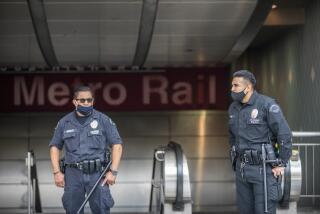East St. Louis Wins in Riverboat Gamble
- Share via
EAST ST. LOUIS, Ill. — If hell has a police department to punish errant officers, it probably looks a lot like the East St. Louis force did for most of the last 15 years.
Paydays were erratic, with officers going as much as six weeks without a paycheck. Hiring was frozen for a decade. The patrol fleet was so broken-down that police sometimes had to ride three to a car. Officers would have to duck into phone booths to call headquarters because their cars didn’t have working radios.
“A lot of times, we couldn’t catch thieves because our top speed was 50 mph,” said Sgt. Lionel Settles, a 25-year veteran of the police force in this impoverished city of 38,000. “You go any faster than that, and your car would start sputtering.”
But deliverance has finally come for East St. Louis’ finest.
Today, the police department has new cars, new guns, new blood and a new attitude, thanks largely to an influx of cash from a riverboat casino that opened on the Mississippi in 1993.
Meanwhile, the mostly black community, which once despised the police almost as much as they did the crack dealers and prostitutes who haunted the streets, is giving officers another chance.
“We used to call the police, and you might not even see them,” said Darlene Jones, a neighborhood organizer whose son was shot and wounded by a gang near her home three years ago. “We’re trying to trust the police now.”
East St. Louis’ murder rate has been dropping since 1991, when 62 were killed, to 33 last year. .
In the same period, the number of working police cars rose from seven to 54, the most Police Chief Isadore Chambers can recall the department having since he joined in 1972.
Since the Casino Queen started pumping $10 million a year into the coffers of the once-bankrupt city, the police budget has been doubled to $4 million, Mayor Gordon Bush said.
Money from the riverboat and from a federal Community-Oriented Policing grant has let the city hire about 40 new officers. There are 87 on the force now. And long-delayed promotions and pay raises are finally trickling in.
In 1977, a consulting firm recommended the whole police force be disbanded. At one point five years ago, the city ran out of gas for its police cars. And in 1990, a state panel took over the city’s finances. It is still in charge.
Today, a major emphasis is on foot patrols and building rapport in neighborhoods and housing projects. Residents can also attend a “citizen academy,” where they learn how to help police solve crimes. The department has a Delta Team of commandos who specialize in storming crack houses. Cooperation among federal, state and local law enforcement has never been better, Chambers said.
The average age of an East St. Louis police officer in 1989 was 46. Today, the face of law enforcement is starting to look more like that of James Jones, a 29-year-old who joined the force two years ago.
“I heard that they’re improving a lot, that things are going in the right direction,” Jones said.
Dennis Meyer, co-owner of Meyer Transportation Inc., recalled how he and his brother had to stand guard after thieves stole dozens of their truck tires.
“We don’t have to call them very much now,” he said, “because everybody realizes they’re here.”
More to Read
Sign up for Essential California
The most important California stories and recommendations in your inbox every morning.
You may occasionally receive promotional content from the Los Angeles Times.













